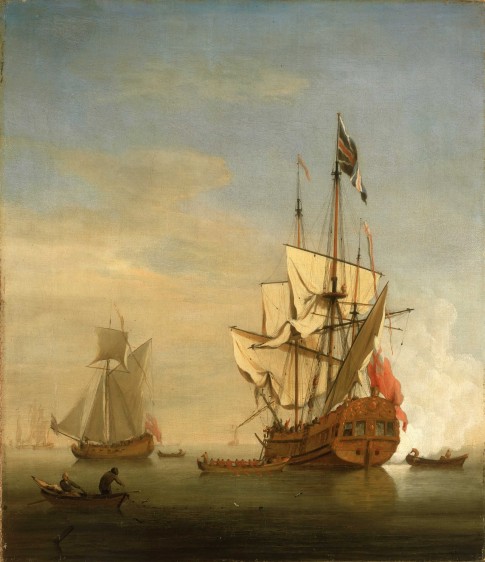AN ENGLISH SIXTH-RATE SHIP FIRING A SALUTE AS A BARGE LEAVES; A ROYAL YACHT NEARBY
by Willem van de Velde, the Younger, 1706
A variety of shipping is shown in a calm. In the foreground on the left a small boat with two figures on board is rowing towards the left. One figure works at the oars and the other is standing up in the boat and attends to a fishing net on the starboard side. To the right is an elaborately decorated sixth-rate ship in port-quarter view. She flies a Union flag at the main and a pendant at the mizzen, which is probably a signal. Her port anchor is visible and may indicate that she is about to anchor. She is flying a salute to starboard as a ship’s barge in the centre pulls away from her port quarter. A figure leans in a leisurely manner from the mizzen top, while other figures are occupied on the deck and in the rigging. In the left middle-distance beyond is a royal yacht, viewed from before the port beam with her mainsail, topsail, foresail and jib set. Other vessels can be seen in the left distance. It is has been suggested that the main vessel is the ‘Peregrine Galley’, which was a 20-gun ship built at Sheerness in 1700, since it resembles an annotated pen and ink drawing of this vessel with manuscript notes relating to her decoration.
The artist was the younger son of Willem van de Velde the Elder. Born in Leiden, he studied under Simon de Vlieger in Weesp and in 1652 moved back to Amsterdam. He worked in his father’s studio and developed the skill of carefully drawing ships in tranquil settings. He changed his subject matter, however, when he came with his father to England in 1672-73, by a greater concentration on royal yachts, men-of-war and storm scenes. From this time painting sea battles for Charles II and his brother (and Lord High Admiral) James, Duke of York, and other patrons, became a priority. Unlike his father’s works, however, they were not usually eyewitness accounts. After his father’s death in 1693 his continuing role as an official marine painter obliged him to be more frequently present at significant maritime events. The painting is signed ‘W.V.Velde J 1706’.
